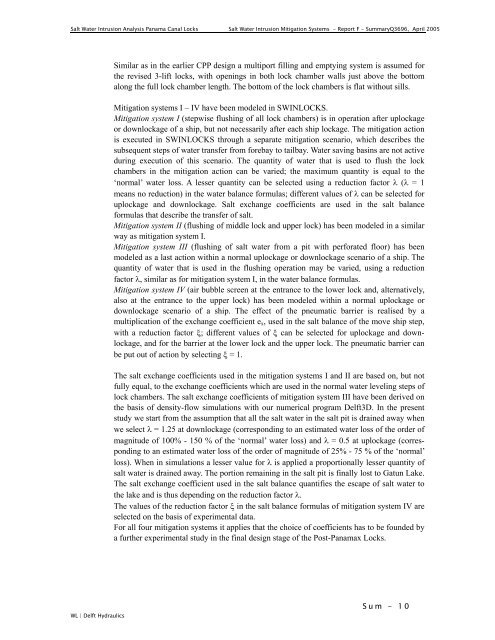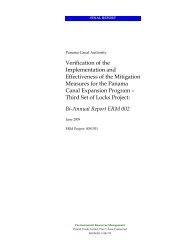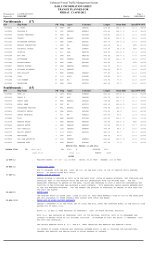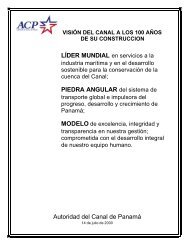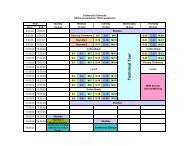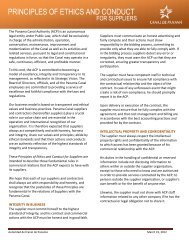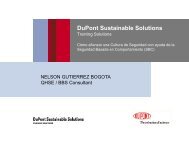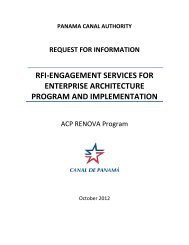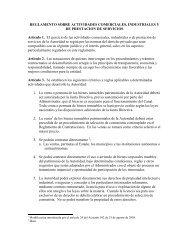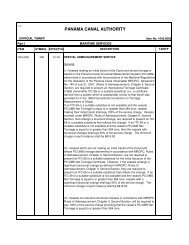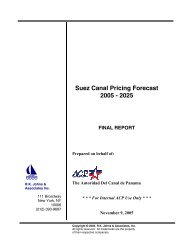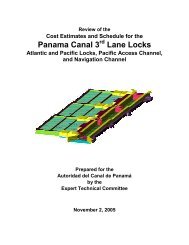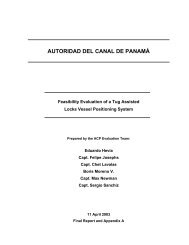Salt water intrusion - Canal de Panamá
Salt water intrusion - Canal de Panamá
Salt water intrusion - Canal de Panamá
Create successful ePaper yourself
Turn your PDF publications into a flip-book with our unique Google optimized e-Paper software.
<strong>Salt</strong> Water Intrusion Analysis Panama <strong>Canal</strong> Locks <strong>Salt</strong> Water Intrusion Mitigation Systems - Report F - SummaryQ3696, April 2005<br />
Similar as in the earlier CPP <strong>de</strong>sign a multiport filling and emptying system is assumed for<br />
the revised 3-lift locks, with openings in both lock chamber walls just above the bottom<br />
along the full lock chamber length. The bottom of the lock chambers is flat without sills.<br />
Mitigation systems I – IV have been mo<strong>de</strong>led in SWINLOCKS.<br />
Mitigation system I (stepwise flushing of all lock chambers) is in operation after uplockage<br />
or downlockage of a ship, but not necessarily after each ship lockage. The mitigation action<br />
is executed in SWINLOCKS through a separate mitigation scenario, which <strong>de</strong>scribes the<br />
subsequent steps of <strong>water</strong> transfer from forebay to tailbay. Water saving basins are not active<br />
during execution of this scenario. The quantity of <strong>water</strong> that is used to flush the lock<br />
chambers in the mitigation action can be varied; the maximum quantity is equal to the<br />
‘normal’ <strong>water</strong> loss. A lesser quantity can be selected using a reduction factor λ (λ = 1<br />
means no reduction) in the <strong>water</strong> balance formulas; different values of λ can be selected for<br />
uplockage and downlockage. <strong>Salt</strong> exchange coefficients are used in the salt balance<br />
formulas that <strong>de</strong>scribe the transfer of salt.<br />
Mitigation system II (flushing of middle lock and upper lock) has been mo<strong>de</strong>led in a similar<br />
way as mitigation system I.<br />
Mitigation system III (flushing of salt <strong>water</strong> from a pit with perforated floor) has been<br />
mo<strong>de</strong>led as a last action within a normal uplockage or downlockage scenario of a ship. The<br />
quantity of <strong>water</strong> that is used in the flushing operation may be varied, using a reduction<br />
factor λ, similar as for mitigation system I, in the <strong>water</strong> balance formulas.<br />
Mitigation system IV (air bubble screen at the entrance to the lower lock and, alternatively,<br />
also at the entrance to the upper lock) has been mo<strong>de</strong>led within a normal uplockage or<br />
downlockage scenario of a ship. The effect of the pneumatic barrier is realised by a<br />
multiplication of the exchange coefficient e x , used in the salt balance of the move ship step,<br />
with a reduction factor ξ; different values of ξ can be selected for uplockage and downlockage,<br />
and for the barrier at the lower lock and the upper lock. The pneumatic barrier can<br />
be put out of action by selecting ξ = 1.<br />
The salt exchange coefficients used in the mitigation systems I and II are based on, but not<br />
fully equal, to the exchange coefficients which are used in the normal <strong>water</strong> leveling steps of<br />
lock chambers. The salt exchange coefficients of mitigation system III have been <strong>de</strong>rived on<br />
the basis of <strong>de</strong>nsity-flow simulations with our numerical program Delft3D. In the present<br />
study we start from the assumption that all the salt <strong>water</strong> in the salt pit is drained away when<br />
we select λ = 1.25 at downlockage (corresponding to an estimated <strong>water</strong> loss of the or<strong>de</strong>r of<br />
magnitu<strong>de</strong> of 100% - 150 % of the ‘normal’ <strong>water</strong> loss) and λ = 0.5 at uplockage (corresponding<br />
to an estimated <strong>water</strong> loss of the or<strong>de</strong>r of magnitu<strong>de</strong> of 25% - 75 % of the ‘normal’<br />
loss). When in simulations a lesser value for λ is applied a proportionally lesser quantity of<br />
salt <strong>water</strong> is drained away. The portion remaining in the salt pit is finally lost to Gatun Lake.<br />
The salt exchange coefficient used in the salt balance quantifies the escape of salt <strong>water</strong> to<br />
the lake and is thus <strong>de</strong>pending on the reduction factor λ.<br />
The values of the reduction factor ξ in the salt balance formulas of mitigation system IV are<br />
selected on the basis of experimental data.<br />
For all four mitigation systems it applies that the choice of coefficients has to be foun<strong>de</strong>d by<br />
a further experimental study in the final <strong>de</strong>sign stage of the Post-Panamax Locks.<br />
WL | Delft Hydraulics<br />
Sum - 10


